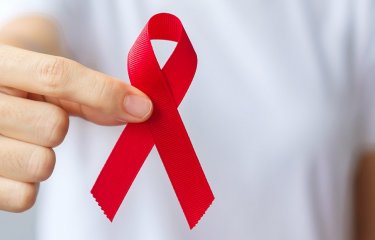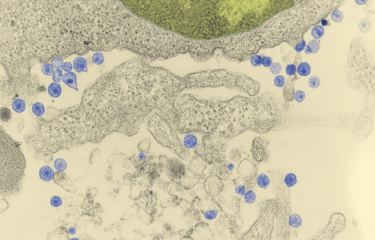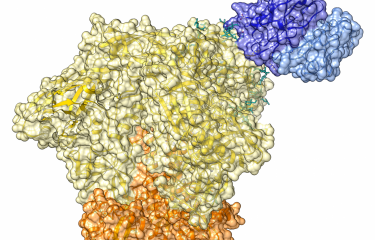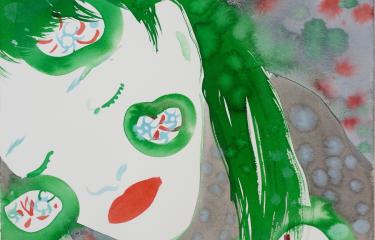Forty years after the discovery of HIV in 1983 at the Institut Pasteur, 38.4 million people were living with the virus worldwide in 2021.[1] Only two cases of people being cured had previously been described: the Berlin patient in 2009 and the London patient in 2019. The IciStem consortium, whose members include Asier Sáez-Cirión's team at the Institut Pasteur, in collaboration with Düsseldorf University Hospital (Germany), the University of Hamburg (Germany), Utrecht University (Netherlands) and the IrsiCaixa AIDS Research Institute (Spain), now present a new case of probable HIV cure, following a bone marrow transplant from a donor with the genetic mutation CCR5-delta 32, known to provide natural protection against HIV. The man, treated in Düsseldorf, received a stem cell transplant to treat leukemia, then was able to stop his antiretroviral treatment for HIV under supervision. Four years later, no trace of HIV virus can be detected in his body. This study offers further proof that it is possible to cure HIV and raises new therapeutic prospects for scientists and clinicians who have devoted their efforts to fighting the virus for the past 40 years. The findings are published on February 20 in Nature Medicine.
The IciStem consortium, of which the Institut Pasteur is a partner, has described the third case of probable cure of HIV infection in the world. The person concerned is a man whose antiretroviral treatment was suspended under supervision after he received a stem cell transplant to treat leukemia. In their analyses, the scientists found no viral particles, no latent viral reservoir and no immune responses against the virus in the body of this individual, despite the fact that his treatment was discontinued four years ago. This is sufficient evidence for the scientific team to consider the "Düsseldorf patient" as having probably been cured from HIV infection.
In 2008, a medical team in Düsseldorf diagnosed a person with HIV infection. In line with the guidelines at the time, the man began antiretroviral treatment in 2010, bringing the infection under control and reducing the quantity of virus to undetectable levels in the blood, like most people receiving treatment. In 2011, the same person was diagnosed with leukemia, a cancer of immune cells in the bone marrow. He underwent chemotherapy and his leukemia went into remission, but after a relapse he needed to have a stem cell transplant from an anonymous donor in 2013. The first stage in selecting a donor is to find someone whose immunogenetic characteristics are compatible with the patient. Then, for individuals living with HIV, a donor with the mutation known as CCR5-delta 32 is sought. This genetic mutation is known to prevent HIV from entering cells, therefore offering protection from infection.
"We know that HIV targets cells in the immune system. With a bone marrow transplant, all the patient's immune cells are replaced by the donor's cells, thereby removing the vast majority of infected cells," explains Asier Sáez-Cirión, Head of the Institut Pasteur's Viral Reservoirs and Immune Control Unit and co-lead author of the study.
The transplant itself also represents a medical challenge: "First, we need to find a donor who is immunogenetically compatible so that the transplant is not rejected. And given that less than 1% of the general population carries this mutation that protects against HIV, it is very rare to find a compatible bone marrow donor with the mutation. So it is quite extraordinary for all these factors to coincide and for the transplant to be successful in curing both conditions, leukemia and HIV," adds the scientist.
More than five years after the transplant, following various complications the patient's condition stabilized. In 2018, the medical team was no longer able to detect the presence of the virus and planned a supervised discontinuation of the patient's antiretroviral treatment for HIV. When the treatment was suspended, the medical team and the scientists monitored the patient for 44 months and detected no traces of viral particles or latent viral reservoirs in the person’s blood or tissues. They were also unable to detect the activation of immune responses characteristic of HIV infection. "Although we were not able to analyze all the person’s tissues to formally exclude the presence of HIV in the body, these results indicate that the immune system did not detect the virus after the treatment was discontinued," comments Asier Sáez-Cirión. Today the Düsseldorf patient is 53 years old and in good health. On the basis of all these data, the scientific team has confirmed that he has probably been cured of HIV infection.
Dr. Björn Jensen from Düsseldorf University Hospital, who led the study, adds that "the transplant process emptied the viral reservoir, and the transfer of resistance to HIV from the donor's cells to the recipient prevented any viruses that may still be present from spreading."
Cases of HIV remission worldwide
Some people are capable of maintaining an undetectable viral load for long periods in the absence of antiretroviral treatment. This is recognized as remission from HIV infection. "This is the case of natural controllers or post-treatment controllers, who we are also studying, whose effective immune responses enable them to control HIV infection even in the presence of the virus," explains Asier Sáez-Cirión. "The case of people who have received a bone marrow transplant goes beyond this situation of control." The description of the probable cure of the Düsseldorf patient was preceded by those of the Berlin and London patients. Two other similar clinical cases, the New York and City of Hope Hospital (Duarte, United States) cases, were presented at scientific conferences in 2022 after 12 months of monitoring with no viral rebound following the discontinuation of antiretroviral treatment. None of these individuals has particular immune characteristics that would enable them to control HIV infection spontaneously. The virus was eliminated from their body following medical treatment for another disease.
However, the therapeutic strategy described in this study is very aggressive and cannot be applied to the rest of the population living with HIV. Stem cell transplants only represent a suitable treatment for people with a hematological disease for whom there is no other therapeutic alternative. For people living with HIV, antiretroviral treatment is currently the best therapeutic alternative.
The Düsseldorf patient is therefore a third proof of concept which demonstrates that it is possible to cure HIV and raises hopes for the scientific community that has been battling the virus for the past 40 years. "Various strategies are under investigation. Some aim to specifically target and eliminate infected cells, others to make cells resistant to infection without the need for a transplant, for example by introducing the CCR5-delta 32 mutation via gene therapy, and still others seek to optimize immune responses to the virus," continues Asier Sáez-Cirión.
"Research on the HIV epidemic is part of a now 40-year-long tradition at the Institut Pasteur. We have accumulated a considerable body of knowledge on the mechanism of action of the virus. But there are still a number of unresolved scientific issues, including how to eliminate the viral reservoir in people with HIV and how to develop an effective preventive vaccine against the virus. Several teams from the Institut Pasteur and the Pasteur Network are working on these topics, and clinical trials will begin in 2023 to test novel immunotherapies based on broad-spectrum neutralizing antibodies and also predictive markers of remission associated with natural killer cells," concludes the Institut Pasteur's Senior Executive Scientific Vice-President, Christophe d'Enfert.
The IciStem consortium
The study was conducted by the international IciStem consortium, which investigates people living with HIV who may receive stem cell transplants as part of treatment for other diseases. "With an excellent team of professionals from all over the world, we are studying those exceptional cases over the past nine years in which the virus has been completely eliminated from the body following a therapeutic strategy. We want to gain a detailed understanding of each stage of the cure process so that we can devise strategies that are reproducible in all people," explains Javier Martinez-Picado, an ICREA scientist at IrsiCaixa, co-PI of IciStem and co-lead author of the article.
[1] UNAIDS
Source
In-depth virological and immunological characterization of HIV-1 cure after CCR5Δ32/Δ32 allogeneic hematopoietic stem cell transplantation, Nature Medicine, Februry, 20th, 2023
Björn-Erik Ole Jensen1,23 , Elena Knops2,3,23, Leon Cords4,23, Nadine Lübke5,23, Maria Salgado6,7,23, Kathleen Busman-Sahay8, Jacob D. Estes8, Laura E. P. Huyveneers9, Federico Perdomo-Celis10, Melanie Wittner4,11, Cristina Gálvez6, Christiane Mummert12,20, Caroline Passaes10, Johanna M. Eberhard4,11,21, Carsten Münk1, Ilona Hauber13, Joachim Hauber11,13, Eva Heger2,3, Jozefien De Clercq14, Linos Vandekerckhove14, Silke Bergmann12, Gábor A. Dunay11,13,22, Florian Klein2,3, Dieter Häussinger1, Johannes C. Fischer15, Kathrin Nachtkamp16, Joerg Timm5, Rolf Kaiser2,3, Thomas Harrer12, Tom Luedde1, Monique Nijhuis9, Asier Sáez-Cirión10,24, Julian Schulze zur Wiesch4,11,24 , Annemarie M. J. Wensing9,17,24, Javier Martínez-Picado6,7,18,19,24 & Guido Kobbe16,24
1Department of Gastroenterology, Hepatology and Infectious Diseases, Dusseldorf University Hospital, Medical Faculty, Heinrich Heine University, Dusseldorf, Germany.
2Institute of Virology, University and University Hospital Cologne, University of Cologne, Cologne, Germany.
3German Center for Infection Research, Partner Site Bonn-Cologne, Cologne, Germany.
4Infectious Diseases Unit, I. Department of Medicine, University Medical Center Hamburg-Eppendorf, Hamburg, Germany.
5Institute of Virology, Dusseldorf University Hospital, Medical Faculty, Heinrich Heine University, Dusseldorf, Germany.
6IrsiCaixa AIDS Research Institute, Barcelona, Spain.
7Center for Biomedical Research in Infectious Diseases, Carlos III Health Institute, Madrid, Spain.
8Vaccine and Gene Therapy Institute and Oregon National Primate Research Center, Oregon Health and Science University, Beaverton, OR, USA.
9Translational Virology, Department of Medical Microbiology, University Medical Center Utrecht, Utrecht, the Netherlands.
10Institut Pasteur, Paris Cite University, HIV Inflammation and Persistence, Paris, France.
11German Center for Infection Research, Partner Site Hamburg-Lubeck-Borstel-Riems, Hamburg, Germany.
12Infectious Diseases and Immunodeficiency Section, Department of Internal Medicine 3, Universitatsklinikum Erlangen, Friedrich-Alexander Universitat Erlangen-Nurnberg, Erlangen, Germany.
13Leibniz Institute of Virology, Hamburg, Germany.
14HIV Cure Research Center and Department of General Internal Medicine and Infectious Diseases, Ghent University Hospital, Ghent, Belgium.
15Institute for Transplant Diagnostics and Cell Therapeutics, Dusseldorf University Hospital, Medical Faculty, Heinrich Heine University, Dusseldorf, Germany.
16Department of Hematology, Oncology and Clinical Immunology, Medical Faculty, Dusseldorf University Hospital, Heinrich Heine University, Dusseldorf, Germany.
17Ezintsha, University of the Witwatersrand, Johannesburg, South Africa.
18University of Vic-Central University of Catalonia, Barcelona, Spain.
19Catalan Institution for Research and Advanced Studies, Barcelona, Spain.
20Present address: Bavarian Nordic, Martinsried, Germany.
21Present address: Helmholtz Center for Infection Research, Helmholtz Institute for One Health, Greifswald, Germany.
22Present address: University Children’s Research, UCR@Kinder-UKE, University Medical Center Hamburg-Eppendorf, Hamburg, Germany.
23These authors contributed equally: Bjorn-Erik Ole Jensen, Elena Knops, Leon Cords, Nadine Lubke, Maria Salgado.
24These authors jointly supervised this work: Asier Saez-Cirion, Julian Schulze zur Wiesch, Annemarie M. J. Wensing, Javier Martinez-Picado, Guido Kobbe.






